Hello, my name is Julie Strietelmeier, and I am a couch potato. There, I’ve said
it…whew… I feel better. Yes, it’s true, I like nothing better than sitting home on the
weekend watching movies and tv shows that I’ve taped during the week while being at work.
When the mini satellite dishes came out, I had to have one (I don’t have cable in my
area). When I found an electronic tv guide program (ETV Host), I had to subscribe to it. And when
I saw a nifty looking gadget on the Tech Center Labs website called The Wedge, I knew it would be no exception. The Wedge
coming in two variations is a hardware learning remote ir device that works with your Palm
III or PalmPilot. To control this hardware requires a software package called WedgeTV. Put The Wedge and WedgeTV together and
you have a terrific combo for all you couch potatoes out there.
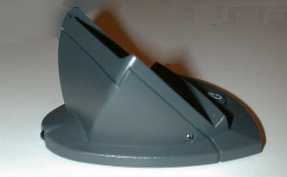 |
Like I said, The Wedge comes in two flavors. If you have a Palm III, you’ll probably want the P3-Wedge. The P3-Wedge is a regular P3 cradle with the cable removed, 2 LED’s and electronic guts added. One led is the transmitter and the other one is the receiver for the learning portion of the remote. The Wedge is powered by 2 AAA batteries. To change the batteries requires you to take the cradle apart. It’s not real difficult, but it can be a pain to get it back together because of the hotsync button. |
| If you own a PalmPilot, you’ll want to get the Pilot-Wedge. This is a metal box that can be used as you see to the right, or by removing the metal cover, it can fit directly onto the back of a regular PalmPilot cradle. I really have to hand it to the Tech Center Lab folks because this little module is very well made and fits like a glove. Just like the other Wedge, there are two LED’s. One difference though is that you have to plug the end of the cradle’s serial cable into the Wedge. The Pilot-Wedge also runs on 2 AAA batteries. Changing them is somewhat easier because you just have to open the back of the module or slide it out from the back of the Pilot cradle to change them. |
 |
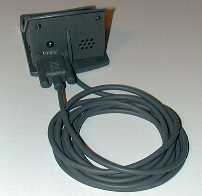
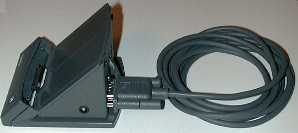 (The speaker holes are for future
(The speaker holes are for future
features.)
So, how do you program this device? It’s a simple matter of using the WedgeTV program.
There are two parts to this program, the actual interface prc and the scheduler hackmaster
extension prc. The interface program is very easy to use. You must first teach it all the
commands from your various remote controls. You then name the device you want to learn
such as TV and start learning the commands. By holding the remote next to the receiver LED
and following the onscreen instructions, you’ll have your remotes learned very quickly.
The basic commands such as Power, channel up, down, volume up and down are already
inserted in the list of commands to learn for you. You can add other commands as
well (up to 400 commands).
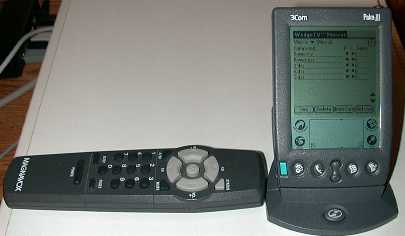
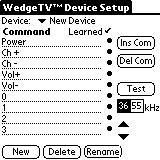
After teaching the hardware all your commands, you then can create a control screen.
This is your GUI interface for building the remote of your dreams. If you want to
build a remote that has Power buttons for your TV, VCR and Stereo all on the same remote,
you can do it. Or, if you want to create a separate screen for each device, you can do
that also and then just cycle through them as needed. Building the control screens is
easy. You just tap on a button and then you select which command it will be from all the
commands that you have learned. You can then associate a graphical icon or text
label for the button. It would be really cool if the WedgeTV folks would allow the user to
add their own graphical icons as well.
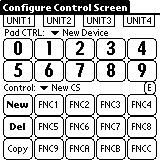
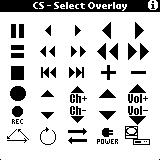
The real power of WedgeTV is in its ability to create macros. Macros allow you to link
together commands to create one command. For example, you could create a macro called
Movies. With this macro, you could have it turn on your TV, turn on your Stereo, turn on
your VCR and press PLAY. Or, as another example, you could create a macro called MTV
that would press the appropriate channel numbers to switch to that channel. You also have
the ability to create macros that include other macros!
Another great feature of this software/hardware combo is the scheduling feature. You
can set up datebook events that call macros and execute them at the correct time.
All this requires is that you make a macro and then in the Datebook application, set an
alarm with the name WTV-RecordXfiles. By putting the ‘WTV-‘ in front of an existing
macro name, when the alarm goes off, the WedgeTV hackmaster hack will execute the
macro. Of course, you’ll have to put your Pilot and Wedge near the devices that
you’re wanting to control when the alarm goes off. I did find that the WedgeTV hackmaster
hack would not work with Datebk3 when Datebk3 was set to handle alarms.
Speaking of leaving the Wedget near the devices that you want to control, I tested the
distance that it would control my TV and ran out of room that I could back up at about
23ft. Also, according to the folks at Tech Center Labs, the batteries in the Wedge module
should last as long as batteries in a regular remote control.
The only problems that I had with the software/hardware combo was getting it to control
my Magnavox TV. It would seem to learn the codes just fine, but then they would
sporadically work. The latest version of the software seems to have fixed this problem
though…
What don’t I like about this product? There really isn’t much… The software
would be perfect if it could import macros and schedule alarms automatically via some
method. Other than that and the fact that you have to leave the Pilot and Wedge near the
devices that you want to control, I can’t think of any. Time to go out and buy an extra
Pilot! 🙂
Price: $30.00 (WedgeTV software), $89 (P3-Wedge Hardware),
$80 (Pilot-Wedge Hardware)
Pros:
Gives you one module that can control all your IR devices.
Ability to create complex macros.
Ability to setup datebook alarms to execute macros.
Cons:
No way to import macros and schedule alarms automatically.
You have to leave your PDA and Wedge in front of the devices that you want to control.
Some compatibility problems with Datebk3.
Google Review Tap Cards (3-Pack) by TapFive - Tap for Instant Reviews - All Phones Compatible - Reusable Smart Tap NFC & QR - Boost Business Reviews - Powered by TapFive (3 Card Pack)
$34.90 (as of December 6, 2025 04:09 GMT -05:00 - More infoProduct prices and availability are accurate as of the date/time indicated and are subject to change. Any price and availability information displayed on [relevant Amazon Site(s), as applicable] at the time of purchase will apply to the purchase of this product.)REVLIXI Google Review Stand -Boost Reviews w/Reusable Google Review Tap Card Stand & QR Code Stand- No App or Subscription - Android & iPhone Compatible-Boost Google Reviews for Online Growth
$24.89 (as of December 5, 2025 17:55 GMT -05:00 - More infoProduct prices and availability are accurate as of the date/time indicated and are subject to change. Any price and availability information displayed on [relevant Amazon Site(s), as applicable] at the time of purchase will apply to the purchase of this product.)Product Information
| Price: | $30.00 |
| Manufacturer: | Tech Center Labs |
| Pros: |
|
| Cons: |
|


